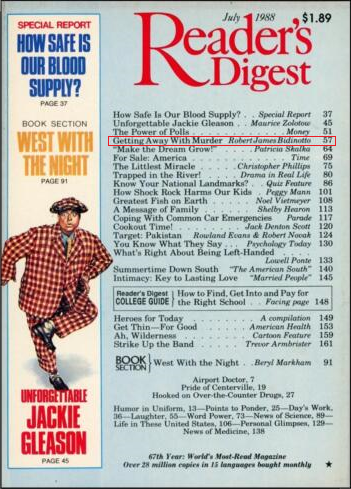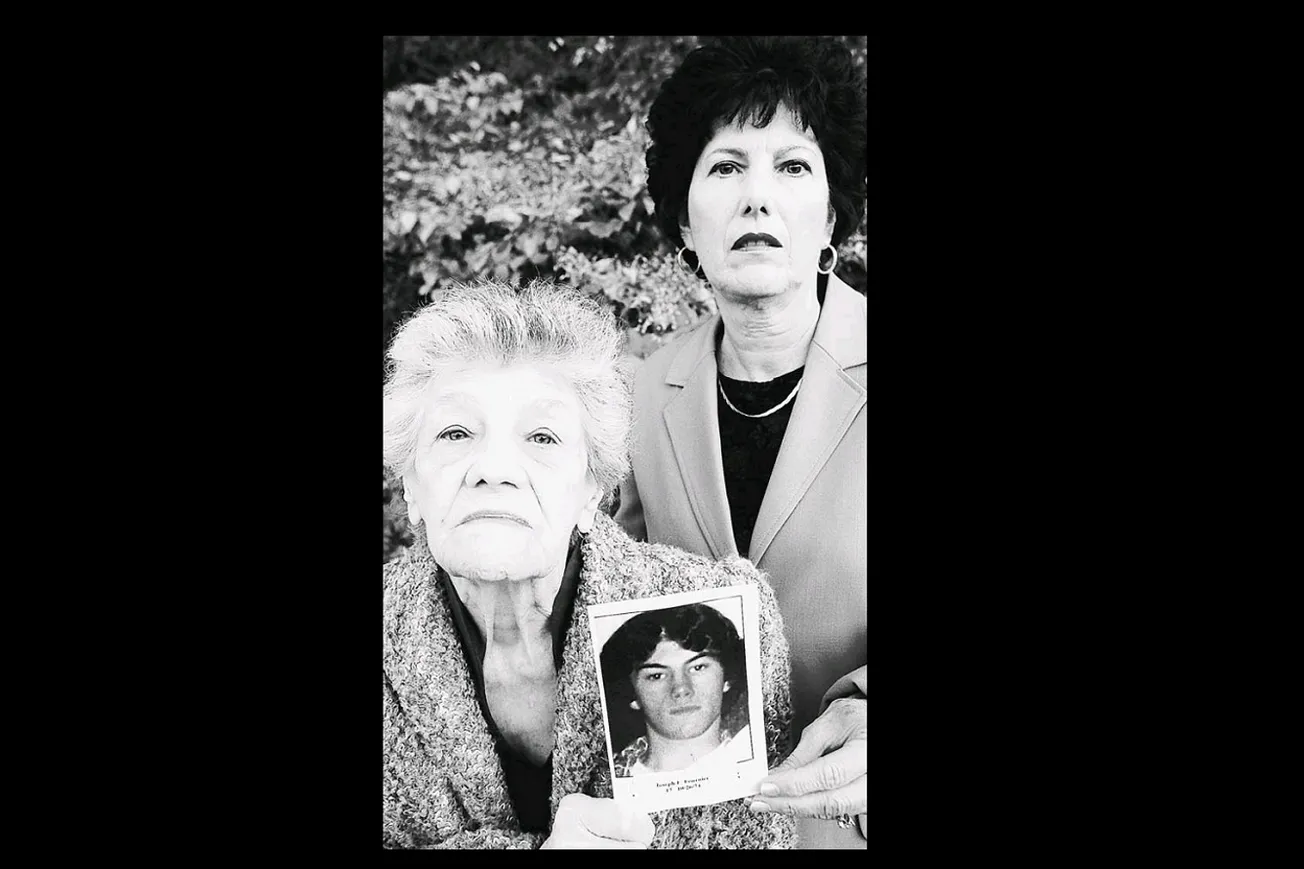EVERYTHING YOU THINK YOU KNOW ABOUT WILLIE HORTON IS BULL
“One of my objectives, quite frankly, is to lock Willie Horton up in jail.” —Joe Biden, Senate Judiciary Committee Chair, bragging Democrats were tougher than Republicans on criminals, 1990
The nation’s 2022 top-tier fear is crime. Three quarters of Americans say violent crime is a major problem, and getting worse. Democrats’ cashless bail laws, attacks on police, and other liberal soft-on-crime policies have unleashed unrestrained criminality across the country, particularly in Democrat-run cities, where dangerous criminals are no longer locked up in jail. At all. “Arrested-and-released” is now the most common phrase in every crime article.
And this is not just theory to people, or some kind of political talking point. According to a recent Golden/TIPP poll, a record 16 percent of Americans themselves or a family member have been victims of crime — and the distressing numbers are particularly elevated among African Americans, Hispanics, and urban voters, where close to 25 percent — one in four — are crime victims.
Republicans are campaigning hard for the midterms on the real problem of crime — and gaining traction everywhere. The Democrat response: “That’s racist! It’s Willie Horton all over again! Shut up!”
•“National Republicans Are Bringing Back Willie Horton-Style Advertisements…” — HuffPost, 9/14/22
•“Racist ‘Willie Horton’-Style Fearmongering on Crime May Win Midterms for GOP: Devoid of actual ideas, the GOP has ripped a racist page from a 1980s playbook to scare voters around crime. The polls suggest it’s working.” — Will Bunch, The Philadelphia Inquirer, 10/2/22
•“‘This is Willie Horton 2.0,’ Cornell Belcher, a Democratic strategist, said… The Republican campaign is streaked with racism, a blatant attempt to exploit white anxiety about dark-skinned felons…” — Santa Maria [CA] Times, 10/4/22
•“Meet Willie Horton, Again.” — The Scranton Times-Tribune, 10/5/22
•“…Republican candidates are turning to a tested ad-campaign strategy: making Democrats look soft on crime.” — Matt Stieb, “It’s Willie Horton Season in the Midterms,” New York Magazine, 10/7/22
•“[C]rime is where [GOP candidate Mehmet] Oz found the sweet spot in the [PA] state’s broader electorate. Crime has long been a go-to issue for Republicans. The echoes of Willie Horton are loud and clear….” — Eleanor Clift, Daily Beast, 10/7/22
•“This is Willie Horton all over…. [T]hat was one of the most racialized, divisive ads in our history…. [I]t’s a playbook that has been used over and over since 1988 for one party [the GOP] to uplift themselves as tough on crime, and the other party [Democrats] as weak on crime and to find opportunities to use these radicalized scare tactics….” — Wendy Daniels, Marquette University professor, quoted in Wisconsin Examiner, 10/7/22
To Democrats, Willie Horton is shorthand for: “Racist Republicans using racist dog whistles to get racist votes.” Democrats spit out this name like a two-word incantation, with total confidence that few current voters have any idea what the real story is. Well, let me lay out some essential details — because everything you think you know about Willie Horton is bull.
Gore’s Gambit. Struggling to stay afloat against the Democrat front-runner in the April 14, 1988 primary debate, Sen. Al Gore (D, TN) tried to hit Michael Dukakis on the Massachusetts governor’s prison furlough program, with a vague, generalized reference to “weekend passes for convicted criminals.” Cold-fish Dukakis responded with statistics and policy-wonkism — sneering that he, unlike Gore, had actually run a criminal justice system. Al went limp, his “you’re-soft-on-crime” attack didn’t impress Democrat primary voters, and Gore dropped out of the race two weeks later, on April 21, 1988.
That Democrat Al Gore first put the issue on the table is occasionally admitted by the media — who always rush to add that Al Gore mentioned no names. True. Which is why this would have likely been the end of the story, except for events happening beyond Democrat Party control.
Forgotten History. One year prior, on April 3, 1987, an inmate supposedly serving a life sentence without the possibility of parole at Northeastern Correctional Center, a state prison in Concord, MA, broke into a random house in Oxon Hill, MD and lay in wait. Clifford Barnes, a 28-year-old car salesman, arrived home at 7:30 pm. The armed convict jumped him, pistol whipped him, gagged him, tied him to a post in the basement, punching, kicking, and stabbing him through seven hours of torture — while laughing. During this nightmare, Barnes’s fiancée Angela Miller walked into the house, and Barnes’s tormenter turned the violence on her. The convict raped a screaming Angela at gunpoint again and again as Barnes struggled to free himself.
After four more hours of hell, Barnes was finally able to loosen his bindings, stumble to a neighbor’s house, and call police. Cops apprehended the attacker in Barnes’s stolen car after a high-speed chase and shootout.
An April 8, 1987 headline in a local Lawrence, MA newspaper, The Eagle-Tribune, read: “Brutal Killer Caught After Vicious Binge.” The brutal killer: William R. Horton, Jr.
Mutilation. And here’s the reason a small Massachusetts paper took note of this story. All of Lawrence well remembered the name William R. Horton, Jr. On October 26, 1974, Joey Fournier, a Lawrence teenager working late shifts at a Lawrence gas station to save money to buy his first car, had been stabbed 19 times and his body stuffed in a garbage can. He bled out, his feet jammed against his chin.
William R. Horton, Jr. and two accomplices were arrested. The three admitted taking $276.37, but fingered each other for the murder. Cops were convinced Horton, who had already served time in South Carolina for assault with intent to murder, was the killer who tortured Joey even as the teen turned over the night’s receipts and begged for his life.
Court documents summarize that “Fournier died as a result of multiple stab wounds to the neck, chest, and” (as one transcript puts it) “other areas of the body.” Horton defenders — who indeed exist on the left — dismiss as rumor any reports that Joey’s genitals were severed. According to the academic journal Federal Probation:
The local newspaper, The Lawrence Eagle-Tribune, covered the case in detail and…fueled public hysteria with inaccurate reporting and sensationalism of Horton’s crimes…. The newspaper reported details of Horton’s crimes without verification. One such example was the report that Joey Fournier was sexually mutilated.
The left has successfully erased this narrative. Seventeen-year-old Joey Fournier pleading for his life is rarely mentioned in this horrible saga, and the condition of his body is never discussed. Reporters still periodically interview Horton, an obviously sympathetic figure to them. Horton, serving two consecutive life sentences plus 85 years at a maximum security prison in Jessup, MD, maintains his innocence of all of it, and complains most bitterly to supportive journalists about Republicans’ supposed racist use of the nickname Willie, which “irks” him. (That, too, is BS, since Willie is how he referred to himself, according to an immediate 1987 declaration by Maryland victim Clifford Barnes, who would know.)
In May 1975 Horton was convicted of armed robbery and murder in the first degree, sentenced to life without parole, and sent to the state prison in Concord, MA. Joey Fournier’s family along with all of Lawrence, MA grieved, but took a measure of peace in the belief that justice was served.
So 12 years later, when a horrific crime took place in Maryland and it came to light that the perp was the same William R. Horton, Jr., it fell to this small local paper to notice — and connect the dots. With the town’s pain after Fournier’s murder still raw, the stunned Eagle-Tribune editors asked: How was Joey’s killer out? The answer to that question was not easy to find, and it remains politically incorrect to this day.
On Furlough. Eagle-Tribune reporter Susan Forrest was stonewalled by the state’s Department of Correction, which denied access to records based on a 1972 law protecting convicted killers’ right to privacy. It looked as if it might be impossible to discover why Horton was no longer in prison.
Forrest wasn’t deterred, even after Gov. Dukakis himself turned down her interview requests. She wrote story after front-page story on the details she uncovered despite the official barricades, 200 articles in all. She reported that after ten years Massachusetts prisoners — even those with life sentences for first degree murder — were transferred to minimum security facilities, where they became eligible for 48-hour “furloughs.” On the (I kid you not) honor system. Completely unmonitored weekend passes.
At the time, there were 160 convicted killers in this Massachusetts pipeline. Dukakis actually vetoed legislation to limit furloughs for murderers — because he said that would “cut the heart out” of his program.
Joey Fournier couldn’t be reached for comment.
No other state even contemplated anything like this. The leftist talking point is that lots of other states had furlough programs, which is true. But not for first-degree murder.
So in June 1986 William R. Horton, Jr., despite a life sentence for torturing and killing an innocent teenager, was on his tenth weekend freebie when he ditched the whole idea of prison. He, like 76 other Massachusetts prisoners at the time, simply didn’t go back. He bummed around Florida for a while, then drifted to the Baltimore area. Nothing happened. There were no alarms, no statewide alerts, no national news bulletins, no BOLO dispatches. Horton was, in effect, a free man. And ten months later, he broke into the home of the young Maryland couple, his next torture victims.
American Outrage. Meanwhile, Reader’s Digest editors had followed The Eagle-Tribune’s local news stories — for which it received a Pulitzer — and began work on a comprehensive report for their enormous national audience. “Getting Away With Murder” by staff writer Robert James Bidinotto appeared in the July 1988 issue, and is still the most thorough coverage of these events. (Bidinotto was assigned the piece in March 1988, a month before Gore’s vague mention.)
The July Digest blanketed the nation at the end of June 1988, over 28 million copies in 15 languages worldwide. This article was not dry policy analysis or criminal justice statistics or a generalized report on a state detention program, though it covered all those elements. It is primarily a horrific story of human suffering and injustice, and lays out in vivid detail what always happens to ordinary people under liberal-run systems of crime-without-punishment. They become victims; they are attacked; they suffer and die.

Tens of millions of Americans were furious.
And here is the crux of the matter: “Getting Away With Murder” made no mention of Horton’s race. Zero. The Digest article included no photos of him, and referred to him by his full name. The facts of the case outraged the public because every reader instantly understood the human cost of this stupid Massachusetts program. Because letting dangerous criminals out to prey on the rest of us is indefensible.
Lee Atwater, George Bush Sr.’s 1988 campaign manager, is typically blamed for the “racist Willie Horton” campaign tactic, but the truth is, the Republican campaign followed the public emotion, and did not lead it. Atwater himself admitted the anti-crime-coddling intensity emerged via groundswell from the grassroots: “I have never seen an issue take on a life of its own like this issue.” Despite the media history revisionism (and Atwater’s subsequent apology), it was not directed by the Republicans from the jump.
As The Washington Post reported just before that election: “On July 4 [1988], Atwater said, he took a vacation to Luray, VA at a time when a group of motorcyclists was there. At dinner, he said, he overheard a conversation between two biker couples about the Reader’s Digest article. ‘It was obvious this issue had a life of its own,’ he said. ‘I kept talking to them about other things. There was zero interest in the Presidential race. But the Willie Horton thing kept sustained interest for 45 minutes.’”
Dukakis didn’t know it, Atwater didn’t know it — and not a single pundit to this day knows it — but the Massachusetts governor, sponsor of the furloughed killer William Horton, had already lost the presidency the moment the July 1988 issue hit subscribers’ mailboxes.
I was a senior editor at The Digest then, and I remember. Reader’s Digest was beneath the radar of the mainstream media and most of the political establishment. But thanks to that powerful little magazine, the vast majority of the American people were informed, took their measure of Michael Dukakis, and sank him in July 1988.
Dukakis was done three months before either the Bush campaign furlough ad or the third-party ad using Horton’s photo ran. Those limited-run TV ads were actually seen by very few voters at the time — less than 1% market share, according to The Washington Post. Instead, the ads live on in the media’s fevered “It’s Willie Horton Again!” pieces every election.
Democrats Chastened. They won’t admit this now, but after Dukakis went down to landslide defeat (8 point margin in the popular vote, 426 to 111 in the Electoral College), Democrats knew perfectly well they had been routed on the issue of crime. Their first and instant tactic was to pretend that any use of the Horton facts was “racist,” a gambit that continues to this day. Their second strategy was to (temporarily) go all law-and-order.
For a few years, afraid to provoke this level of voter punishment again, Democrat politicians cynically jumped on the “lock-’em-up-and-throw-away-the-key” bandwagon. Which explains the 1990 Biden quote at the top of this article about wanting to “lock Willie Horton up in jail,” Biden’s boast that his 1992 crime bill providing 53 death-penalty offenses did “everything but hang people for jaywalking,” the 1994 Clinton Crime Bill, Hillary Clinton’s “super-predators” smear, and so on.
As public radio’s “The Takeaway” reported in 2015:
The Willie Horton [issue] had implications that stretched far beyond the 1988 campaign season — it ultimately pushed a button of fear that marked the beginning of a “tough on crime” era, the consequences of which we are still grappling with today. “It had a tremendous impact,” says [Marshall Project editor Bill] Keller. “It taught Democrats that this was an issue where they had to be more Catholic than the Pope; tougher than tough. I think you can draw a line between the Willie Horton ad in 1988 and Bill Clinton’s tenure as president, who passed the 1994 crime act, which included nearly $10 billion for building more prisons, 100,000 more cops on the streets, and took away Pell education grants for prison inmates. He wasn’t exceptional — that law was actually drafted by a senator named Joe Biden.” The Willie Horton ad forced the Democratic Party to take a harder approach to crime — an approach that often pushed for the destruction of furlough programs, for longer sentences, and for the removal of educational opportunities for inmates.
The election paralyzed liberal “criminal justice reform” for decades. Due to “the lingering specter of Willie Horton,” as The New York Times put it seven years ago, “lawmakers are reluctant to campaign on a platform of letting felons out of prison.”
Well, now they’ve outgrown all that.
Democrats Revert. With Democrats’ reclaiming full national power in 2020 and capitalizing on their control of big cities — and forgetting the harsh political lessons they were taught by outraged voters over a generation ago — Democrats have eagerly returned to their criminal-coddling roots. True to form, they are letting felons out of prison. Proudly. And everywhere they rule.
They have implemented their favorite leftist soft-on-crime policies, like non-prosecution of offenses. They have commuted sentences. They have eliminated cash bail. They have saved their harshest rhetoric and punitive policies for police. To put it succinctly, Democrats have, in places they run, basically decriminalized crime.
And we see the result: public fear. To the left, that’s simply due to racist Republicans whipping up false emotion by manipulating voters’ “lizard brain” ignorance. But here’s the real reason people are afraid: criminals, unrestrained by conscience or law, have been set free to hurt them. (Just google “random attack” for dismaying examples.)
In 1988, Democrats had a “Willie Horton problem.” Their problem was: Willie Horton. In other words, the Democrats’ problem was the facts of the case, the truth of what actually happened in the real world — the horror — as a direct result of Democrat policies.
In 2022, the Democrats’ problem is the same as before, the predators they let out to prey on the innocent. But now, the Democrats have moved on and moved up. Their criminals aren’t rewarded with a mere weekend furlough — these days they get a forever furlough. These criminals own the streets — and virtually imprison the rest of us.
The results are utterly predictable. As is the voter response, coming November 8.
Diana Allocco was managing editor of The Limbaugh Letter for its entire 29-year run. Before that, she was senior staff editor at Reader's Digest.









